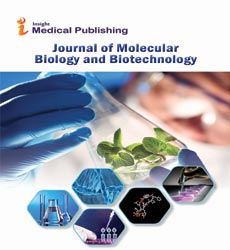Mapping and Blotting of Nucleic Acids
Julia Yan*
Department of Applied Molecular Biology, University of Parakou, Parakou, Benin
- *Corresponding Author:
- Julia Yan
Department of Applied Molecular Biology,
University of Parakou,
Parakou,
Benin,
Email: yanjulia@hotmail.com
Received Date: November 17, 2021; Accepted Date: November 30, 2021; Published Date: December 07, 2021
Citation: Yan J (2021) Mapping and Blotting of Nucleic Acids. J Mol Biol Biotech Vol.6 No.S1:e001.
Description
Nucleic corrosive smudging is a grounded strategy for finding a quality or arrangement of interest from a complicated combination of DNA or RNA. Following electrophoresis, Southern or Northern smudging includes the exchange and immobilization (smearing) of nucleic acids from the gel to a strong help (layer).
DNA Blotting
Electrophoresis of DNA limitation pieces permits partition dependent on size to be conveyed out; however, it provides no indication as to the presence of a specific, desired fragment among the complex sample. This can be achieved by transferring the DNA from the intact gel onto a piece of nitro-cellulose or nylon membrane placed in contact with it. This gives a more long-lasting record of the example since DNA starts to diffuse out of a gel that is left for a few hours. In the first place, the gel is absorbed soluble base to deliver the DNA single abandoned. It is then moved to the layer so the DNA becomes bound to it in precisely the same pattern as that originally on the gel. This exchange, named a Southern smear after its designer Ed Southern, can be performed electrophoretically or by drawing large volumes of buffer through both the gel and the membrane, thus transferring DNA from one to the other by capillary action’s The point of this operation is that the membrane can now be treated with a labelled DNA molecule, for example a gene probe. This single abandoned DNA test will hybridize under the right conditions to correlative fragments immobilised onto the membrane. The states of hybridisation, including the temperature and salt con-centration are critical for this process to take place effectively. This is generally alluded to as the toughness of the hybridisation and it is specific for each individual gene probe and for each sample of DNA. A progression of washing ventures with cradle is then completed to eliminate any unbound test and the membrane is developed after which the precise location of the probe and its target may be visualised.
RNA Blotting
A similar essential course of nucleic corrosive smearing can be utilized to move RNA from gels onto similar membranes. This allows the identification of specific mRNA sequences of a characterized length by hybridisation to a marked quality test and is known as Northern smearing. With this strategy it is feasible to recognize explicit mRNA particles as well as to quantify the relative amounts of the specific mRNA. It is regular to isolate the mRNA records by gel electrophoresis under denaturing conditions since this improves resolution and allows a more accurate estimation of the sizes of the transcripts. The organization of the smearing might be changed from move from a gel to guide application to spaces on a specific blotting apparatus containing the nylon membrane. This is named opening or dab blotching and gives a convenient method for estimating the abundance of specific mRNA transcripts without the need for gel electrophoresis; it does not however provide information regarding the size of the fragments.
A further strategy for RNA examination that beats the issues of RNA smudging is termed the ribonuclease protection assay (RPA). This is an answer based technique where a test that is correlative to the mRNA of interest is bound to form a hybrid that is resistant to digestion with RNAse. Subsequently while other single abandoned RNA atoms are processed the flawless half breeds can be further analysed by gel electrophoresis.
Gene Probe Derivation
The accessibility of a quality test is fundamental in numerous atomic science methods yet in many cases is one of the most difficult steps.' The information needed to produce a quality test might come from many sources however with the turn of events and complexity of genetic databases this is usually one of the first stages. There are various hereditary information bases all through the world and it is feasible to look these over the Internet and identify particular sequences relating to a specific gene or protein. At times it is feasible to utilize related proteins from a similar quality family to acquire information on the most useful DNA sequence. Similar proteins or DNA progressions yet from different species may moreover give a beginning point with which to produce a so-called heterologous gene probe. Albeit at times tests are now created and cloned it is conceivable, equipped with a DNA sequence from a DNA database, to chemically synthesize a single stranded oligonucleotide probe. This is generally embraced by PC controlled quality synthesizers, which connect dNTPs together based on a desired sequence. It is crucial for complete specific checks before test creation to decide that the probe is unique, is not able to self-anneal or that it is self-complementary, all of which may compromise its use.
Open Access Journals
- Aquaculture & Veterinary Science
- Chemistry & Chemical Sciences
- Clinical Sciences
- Engineering
- General Science
- Genetics & Molecular Biology
- Health Care & Nursing
- Immunology & Microbiology
- Materials Science
- Mathematics & Physics
- Medical Sciences
- Neurology & Psychiatry
- Oncology & Cancer Science
- Pharmaceutical Sciences
